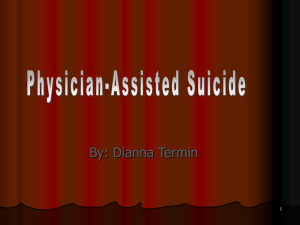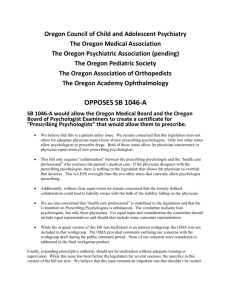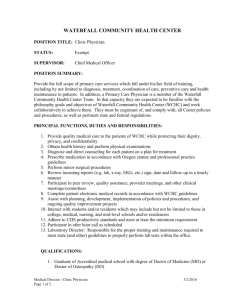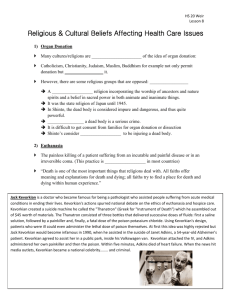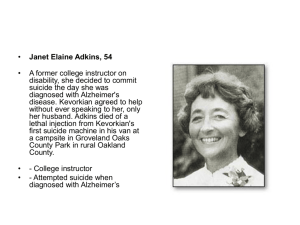Final Reserch Paper on Physican Assisted Suicide
advertisement
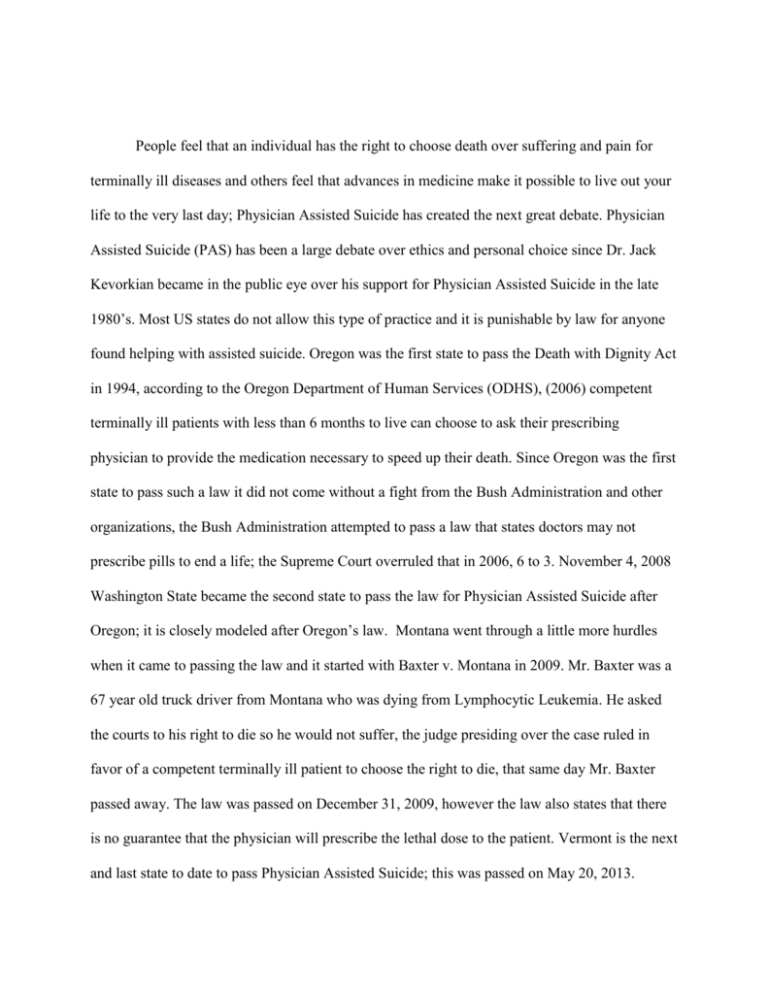
People feel that an individual has the right to choose death over suffering and pain for terminally ill diseases and others feel that advances in medicine make it possible to live out your life to the very last day; Physician Assisted Suicide has created the next great debate. Physician Assisted Suicide (PAS) has been a large debate over ethics and personal choice since Dr. Jack Kevorkian became in the public eye over his support for Physician Assisted Suicide in the late 1980’s. Most US states do not allow this type of practice and it is punishable by law for anyone found helping with assisted suicide. Oregon was the first state to pass the Death with Dignity Act in 1994, according to the Oregon Department of Human Services (ODHS), (2006) competent terminally ill patients with less than 6 months to live can choose to ask their prescribing physician to provide the medication necessary to speed up their death. Since Oregon was the first state to pass such a law it did not come without a fight from the Bush Administration and other organizations, the Bush Administration attempted to pass a law that states doctors may not prescribe pills to end a life; the Supreme Court overruled that in 2006, 6 to 3. November 4, 2008 Washington State became the second state to pass the law for Physician Assisted Suicide after Oregon; it is closely modeled after Oregon’s law. Montana went through a little more hurdles when it came to passing the law and it started with Baxter v. Montana in 2009. Mr. Baxter was a 67 year old truck driver from Montana who was dying from Lymphocytic Leukemia. He asked the courts to his right to die so he would not suffer, the judge presiding over the case ruled in favor of a competent terminally ill patient to choose the right to die, that same day Mr. Baxter passed away. The law was passed on December 31, 2009, however the law also states that there is no guarantee that the physician will prescribe the lethal dose to the patient. Vermont is the next and last state to date to pass Physician Assisted Suicide; this was passed on May 20, 2013. Vermont also is geared around Oregon as it states that the patient must be a competent terminally ill patient that has 6 months to live. Outside the United States there are other countries that do allow Euthanasia as they state it in other countries, according to (Humphrey) they are, Switzerland (1940), Colombia (1997), Albania (1999), The Netherlands (2002) , Belgium (2003), Luxembourg (2008). Knowing the difference between Physician Assisted Suicide and Euthanasia as they are greatly different is important knowledge since the United States uses Death with Dignity or PAS and outside of the US they use the term Euthanasia. PAS refers to a patient’s willful and intentional ending of his or her own life with the assistance of a physician prescribing the medication. Euthanasia refers to the direct administration of a lethal agent to a patient by the doctor with a merciful intent after the patient’s explicit informed request. The step for an individual to get the PAS is a lengthy thought out process that has to be made by the competent patient. Oregon was the first state to pass PAS and most of the other states in the US have geared there law around the Death with Dignity Act. In Oregon an individual must be a resident, 18, deemed competent and capable health care decisions and diagnosed with a terminal illness that has 6 months or less to live. The patient requests the prescription from an Oregon based physician, however before the individual can receive that prescription they must make two oral requests separated by at least 15 days. The patient must also make a written request that is signed with two witnesses there. There are stipulations to whom the witnesses can be, these rules are here to protect the patient from any intentional harm from outside people. One of the witnesses cannot be a family by blood, marriage, adoption or entitled to any of the patients’ estate following the death of said patient. The witness cannot be affiliated with the facility that is prescribing the medication and the prescribing doctor cannot be a witness either. (ODHS, 2006) Following the mentioned requirements there are still more stipulations for the patient to access the prescription. The prescribing physician and another consulting physician must not only agree on the diagnosis but the prognosis as well. They must also determine if the patient is in sound mind and capable or making such choices and the doctors have discussed other options and alternatives such as hospice and pain control. If at any time either doctor feel the patient is being impaired by a psychiatric or psychological condition they can refer the patient for a mental evaluation. The next step is not required by the patient however the prescribing physician must request that the patient notify next of kin. Finally the last step is the prescribing physician must by law notify the Department of Human Services all prescriptions they are prescribing that are lethal. After which a 48 hour waiting period after receiving the written requests that is when the physician may write the lethal dose to be picked up at the pharmacy. Dr Jack Kevorkian was a huge part that started the debate between PAS and the pros and cons of it. He was a Michigan based medical pathologist that created a machine in the late 1980’s that could administer a narcotic followed by a lethal dose of potassium chloride to patients ensuring that their death was fast and painless. Dr. Kevorkian was an advocate for the PAS in believing that people should not have to suffer their last days, that the individual has the right to choose this path. With these thoughts and first PAS in 1989 he made the nation talk about him and his practices which allowed the United States to begin the process of passing laws and asking what is and is not ethical. In 1989 Dr. Kevorkian assisted in the death of Janet Adkins from Portland, Oregon and was charged in his home state of Michigan in connection to her death; however charges were dropped in 1990 after the courts ruled that he did not break any laws. After Janet Adkins death many laws and ethical discussions were brought up regarding PAS and even though Dr. Kevorkian stayed out of prison he was sought after in many legal issues for the next ten years. One of his major legal troubles came in 1998 when he directly administered the lethal does to Thomas Youk that was dying from Lou Gehrig's disease. Instead of just simply providing the means to inject the lethal does Dr. Kevorkian actually administered it. On top of this Dr. Kevorkian videotaped Youk’s injection and death with the intent of broadcasting it; it was later aired on 60 minutes two months later. After the airing of that death Dr. Kevorkian was charged once again in Michigan court with murder and sentenced to 10-25 years in prison however he only served 8 years on the condition that he would not assist with any other PAS, four years after his release he died in 2011. Reference List Westefeld J, Doobay A, Hill J, Humphreys C, Sandil R, Tallman B. The Oregon Death with Dignity Act: The Right to Live or the Right to Die?. Journal Of Loss & Trauma [serial online]. May 2009;14(3):161-169. Available from: Academic Search Premier, Ipswich, MA. Accessed November 8, 2013. Knickerbocker B. Montana becomes third state to legalize physician-assisted suicide. Christian Science Monitor [serial online]. January 2, 2010:1. Available from: Academic Search Premier, Ipswich, MA. Accessed November 8, 2013 Tamayo-Velázquez M, Simón-Lorda P, Cruz-Piqueras M. Euthanasia and physician-assisted suicide: Knowledge, attitudes and experiences of nurses in Andalusia (Spain). Nursing Ethics [serial online]. September 2012;19(5):677-691. Available from: Academic Search Premier, Ipswich, MA. Accessed November 11, 2013. Humphrey, Derek. Final Exit. 28 August 2010. Article. 11 November 2013 Westefeld J, Doobay A, Hill J, Humphreys C, Sandil R, Tallman B. The Oregon Death with Dignity Act: The Right to Live or the Right to Die?. Journal Of Loss & Trauma [serial online]. May 2009;14(3):161-169. Available from: Academic Search Premier, Ipswich, MA. Accessed November 11, 2013. Hosseini H. Ethics, the Illegality of Physician Assisted Suicide in the United States, and the Role and Ordeal of Dr. Jack Kevorkian before His Death. Review Of European Studies [serial online]. December 2012;4(5):203-209. Available from: Academic Search Premier, Ipswich, MA. Accessed November 13, 2013.
